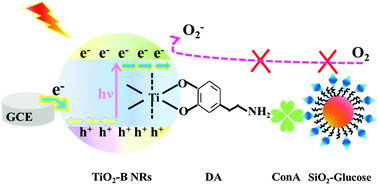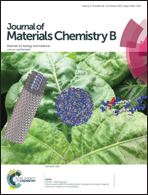TiO2-B nanorod based competitive-like non-enzymatic photoelectrochemical sensing platform for noninvasive glucose detection†
Abstract
TiO2-B nanorods, with excellent properties including large specific surface area, open structures with significant voids, and continuous channels, were explored for the first time in the photoelectrochemical biosensing field. To reduce the destructive effect of UV light on biomolecules, dopamine was introduced onto the TiO2-B nanorod surface through the coordination of dopamine to the undercoordinated titanium atoms of the TiO2-B nanorods, which makes the complex a promising matrix for subsequent biosensing. Furthermore, concanavalin A as a recognition element was attached onto the TiO2-B nanorod/dopamine modified electrode surface by virtue of covalent interaction between concanavalin A and dopamine. Accordingly, a new competitive-like non-enzymatic photoelectrochemical biosensor was established by using glucose labeled SiO2 nanospheres of fixed concentration as photoelectrochemical signal inhibitors competing with target glucose of various concentrations for reaction with concanavalin A. Moreover, this ultrasensitive biosensor with excellent analytical performance was successful applied to noninvasive glucose determination in human saliva. Promisingly, the successful application of TiO2-B nanorods in this research provides a new consideration in the selection of excellent photoactive materials for photoelectrochemical sensing.


 Please wait while we load your content...
Please wait while we load your content...